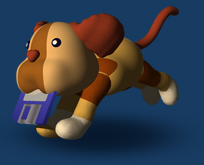Your best friend for file transfer.
 Fetch
Fetch
 Fetch Help > Concepts > Shortcuts
Fetch Help > Concepts > Shortcuts
Shortcuts are a quick way to access files or folders that are available over the Internet, similar to bookmarks or favorites in web browsers. They let you access items without typing in connection information each time.
A shortcut contains the following information: a name for the shortcut, so you can identify it later; the kind of shortcut it is; the hostname of the server that the shortcut refers to; the username for your account on the server that the shortcut refers to (if necessary); the password for that account (if necessary); the connection type to use for accessing the server; the path to the remote folder or file (if desired); and some other options such as a special port to use or whether to use encryption when accessing the server.
There are three kinds of shortcuts: file, folder, or unknown. A file shortcut refers to a single file. A folder shortcut refers either to a remote folder or to a server. A shortcut whose kind is unknown indicates that Fetch could not determine if the shortcut refers to a file or a folder.
Typically shortcuts are stored in the Fetch Shortcuts window. This window is automatically saved (in your Preferences folder) and automatically reopened when you start Fetch. To display the Fetch Shortcuts window, choose Shortcuts > Show Shortcuts. The shortcuts in the Fetch Shortcuts window can be accessed from several locations in Fetch, such as the Shortcuts menu and the New Connection dialog. See the Fetch Shortcuts help topic for more information.
To create a new shortcut, use the Make Shortcut command in the Shortcuts pop-up menu of the New Connection dialog, or choose Shortcuts > New Shortcut, which displays the New Shortcut dialog. See the creating a shortcut help topic for detailed steps.
To make the New Connection dialog always open filled with information from a shortcut, set a shortcut to be the default shortcut. You can do this using the Default shortcut preference in the General Preferences pane, or you can create a default shortcut using the Make Shortcut command in the New Connection dialog. See the making Fetch start with information for your server or website help topic for more information.
To delete a shortcut, select the shortcut in the Fetch Shortcuts window and choose Edit > Delete or press the Delete key. To change a shortcut, select the shortcut in the Fetch Shortcuts window and choose Shortcuts > Edit Shortcut. For more information, see the deleting or changing a shortcut help topic.
When you open a connection that matches one of your shortcuts, the name of the shortcut is displayed in the title bar of the transfer window.
You can also create lists of shortcuts separate from the Fetch Shortcuts window. These are called shortcut list windows. Unlike the Fetch Shortcuts window, they are not automatically saved and reopened. To create a shortcut list window, choose Shortcuts > New Shortcut List . See the shortcut list window help topic for more information.
Two other shortcut-related items are droplet shortcuts and shortcut documents.
Droplet shortcuts are used to access remote folders from the Finder or the Dock. You can drag files to a droplet shortcut to have Fetch upload those files, or double-click it to open a remote folder in Fetch. To create a droplet shortcut, select a folder in a transfer window or a shortcut in the Fetch Shortcuts window, and then choose File > Save Droplet Shortcut. See the Save Droplet Shortcut help topic for more information.
A shortcut document is a document that refers to a file on a server, and will download the file when you double-click on the shortcut document. For example, if you download a file frequently, you can create a shortcut document referring to that file and then just double-click on the shortcut document in the Finder or Dock to accomplish the task. To create a shortcut document, select a remote file in a transfer window, then choose File > Save Shortcut. See the shortcut documents help topic for more information.
Passwords for shortcuts are stored securely in your keychain.
Related topics:
